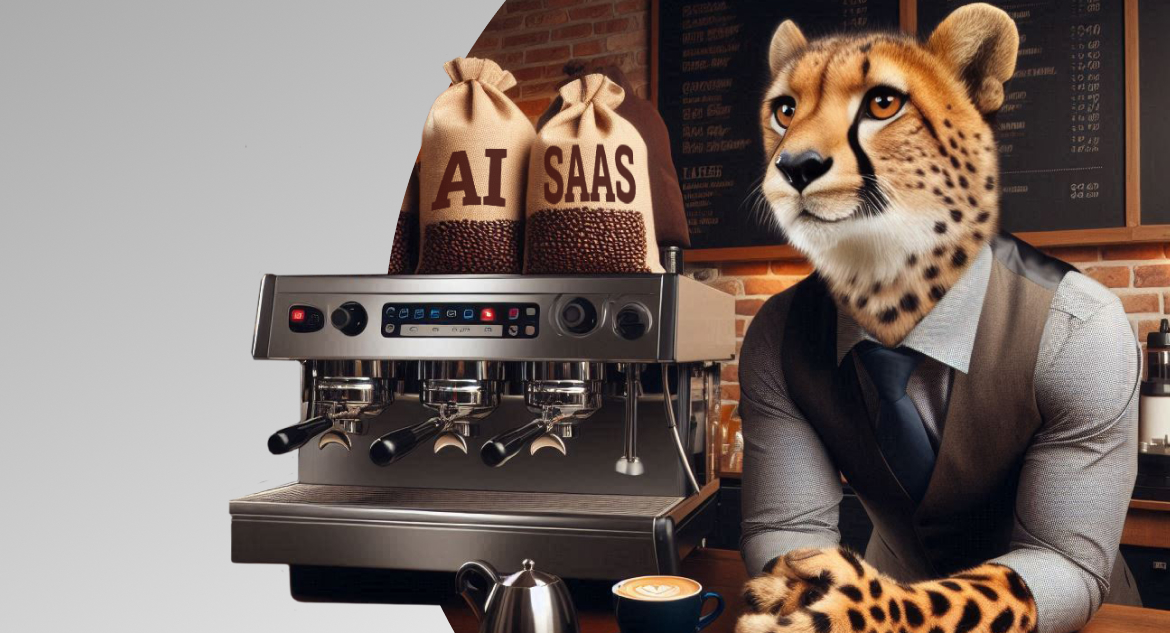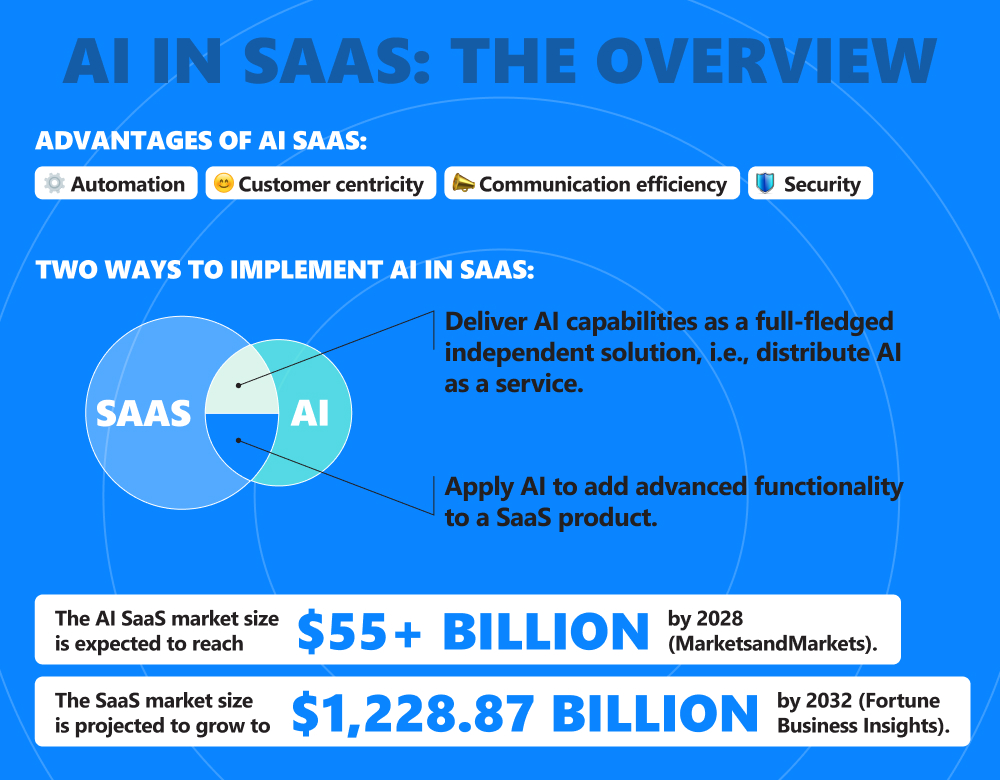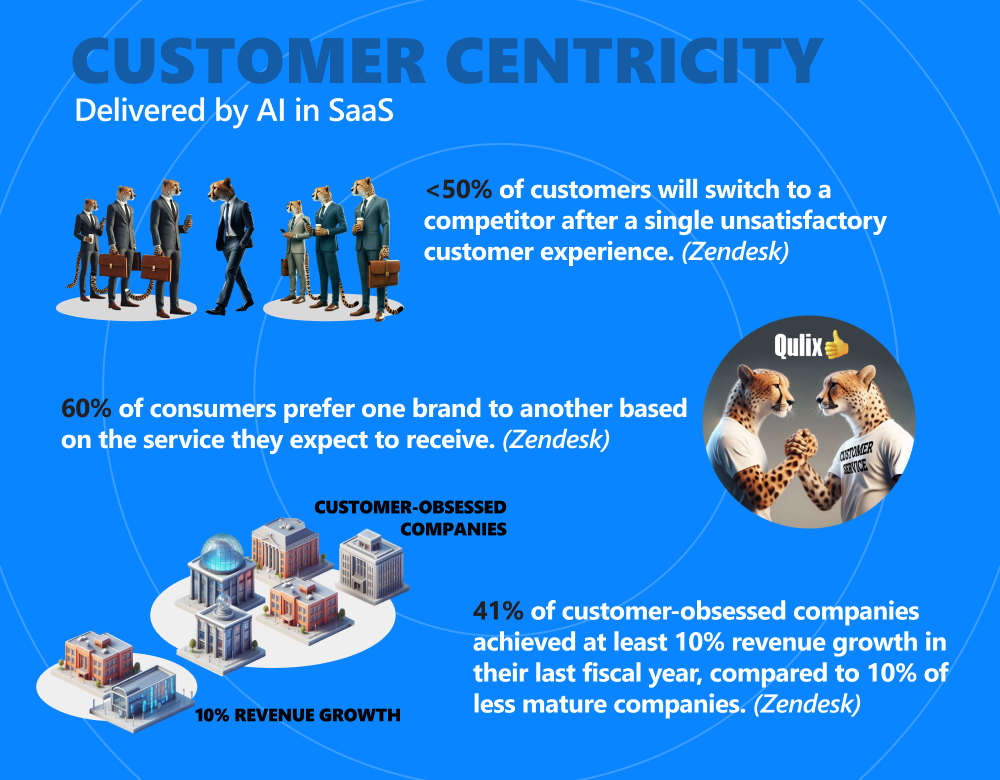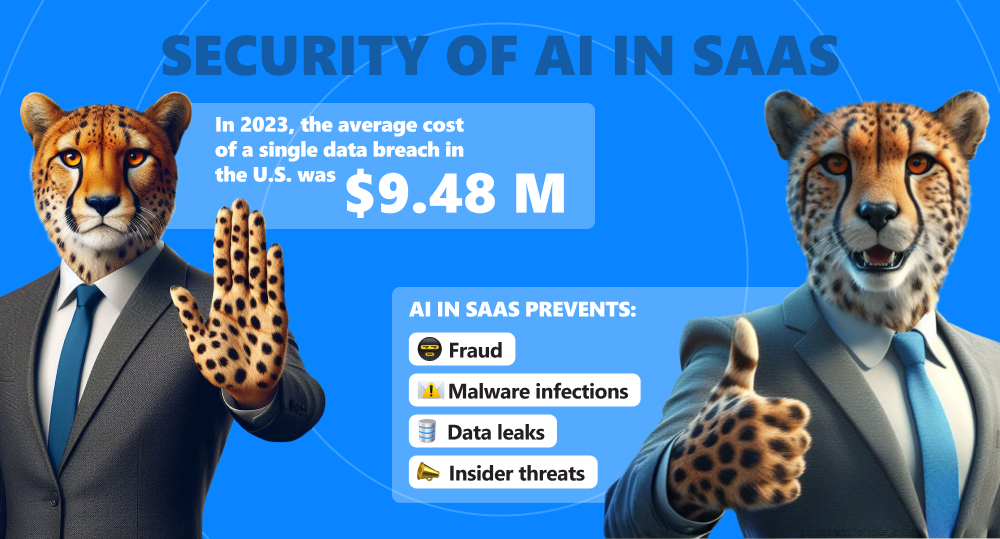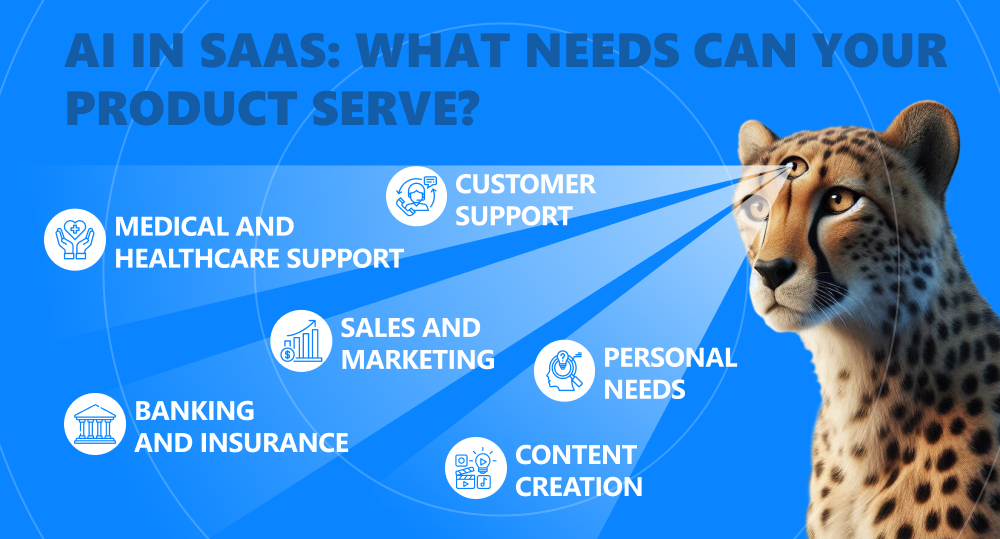The AI SaaS market size was worth more than $9 billion in 2023 and is expected to top $55 billion by the end of 2028 (MarketsandMarkets). Regardless of how impressive that sounds mathwise, this sentence might bring about more questions than answers. What is SaaS? What does AI have to do with it? Is their synthesis potent enough to produce megabucks at that speed, and if so, how? Above all, should your company be thinking about the adoption of AI SaaS solutions?
We cover these questions and more in the article. Dig right in!
written by:
Denis Syropushchinsky
Project Manager
Contents
What the Heck Is AI SaaS?
SaaS, or Software as a Service, is a way of delivering applications over the Internet. If you need a certain application, but you don't want to install and maintain it on your device, you can simply access it via the cloud as a subscription-based service. SaaS grants you the luxury of starting to work ASAP and steering clear from software and hardware maintenance hassle.
Apart from convenience for the end user, a SaaS business is a very sweet deal for companies. Unlike on-premises software, cloud solutions promote cost-efficiency, scalability, and mobility, which are among the key drivers of the SaaS expansion.
Additionally, with SaaS, cloud security is on another level. As Fortune Business Insights writes, even in such an intricate sphere like banking, most organizations have already transitioned from on-premise self-hosting solutions to public or private cloud. AWS, a globally recognized public cloud provider, says that their company backs their cloud infrastructure by a deep set of 300 security services and features. That is a good enough argument for businesses to accept the invite to the realm of SaaS development. Also, it's a perfect foundation for Fortune Business Insights to safely make predictions, “the SaaS market size is projected to grow from $317.55 billion in 2024 to $1,228.87 billion by 2032”.
*Psst… Interested in SaaS development? Check out our SaaS development services.
AI + SaaS = ?
The emergence of artificial intelligence (AI) was yet another contributing factor of the SaaS surge. It offers many great things, like machine learning technologies, deep learning, and natural language processing (NLP). Combined, they opened a portal to data science, big data analytics, predictive analytics, and data-driven decision-making. These benefits set a new bar for software developers worldwide. Hence, to produce data-centric, neoteric products that are in high demand now, SaaS companies had to leverage AI tools, especially the potential of machine learning algorithms.
There are two meanings behind AI SaaS:
- It is possible to deliver AI capabilities as an independent solution, i.e., distribute AI as a service. Take a look at Akkio, an artificial intelligence as a service company: they propose AI-powered forecasting and optimization to businesses. Those AI operations encompass their scope of work.
- Alternately, you can seize the power of artificial intelligence and with its help improve a SaaS product that doesn't revolve around AI. Think Zoom, a phenomenally popular service for online conferences. The program utilizes AI merely to enhance video quality and minimize background noise during video calls. That is more of a cherry on top kind of situation, rather than the main sweet treat.
Regardless of how AI and SaaS merge, together, they help companies serve customers better, increase revenue, and elevate productivity. As this research shows, generative AI (the type of artificial intelligence capable of generating content like text, video, images, code, etc.) “improves users’ performance by 66%, averaged across 3 case studies. More complex tasks have bigger gains, and less-skilled workers benefit the most from AI use.” Now imagine how much money a business can make if it offers a gen AI service on a subscription basis, freeing entrepreneurs from the effort and the expenses of developing their own solution or installing and maintaining a third-party program.
While the adoption of AI into SaaS is still in its early stages, their combined force equates to highly beneficial solutions. They are too good to resist, hence the demand and the market growth. It's time to take a closer look at the generous offerings of the progress.
What Advantages Does AI in SaaS Bring to Companies? (Use Cases Included!)
We've hand-picked a few most prominent benefits that a software as a service solution can acquire only with the help of AI systems.
Automation
Often times, when people talk about automation, they think about reinventing manual labor. Yet, automation tackles a much broader range of activities. You can delegate mundane tasks, data entry, and report generation, use AI chatbots for customer service, and enhance marketing operations. All that is merely a tip of the iceberg which we get to explore thanks to AI and machine learning.
- Xor.ai. The company utilizes a SaaS model for products that transform human resource and give the green light to talent acquisition workflow automation. Machine learning, AI, and AI-powered chatbots brew up a powerful potion to cure headaches, triggered by recruitment pains.
- Custify. This SaaS product allows to dig deep into AI-driven insights and strengthens relationships with customers without extra marketing efforts. Custify allows businesses to keep their finger on the pulse of user behavior and automate repetitive tasks like onboarding and outreach. These processes normally require a lot of time and effort from marketing teams and affect customer satisfaction rates. Custify increases marketing effectiveness and customer lifetime value to boost retention and prevent churn.
- Sisense. Sisense Reporting is here to provide speedy and accurate business and operations reporting. The service allows users to assemble and patch together data from a variety of relevant resources and turn it into actionable insights. Sisense offers more than 120 integration options (Dropbox, Jira, Asana, etc.) and features like query builder, data connectors and visualization, business intelligence, and more.
Customer Centricity
AI redefines the way we collect, store, process, and use business data. Customer information is its integrate part, hence AI models dedicate special attention to it.
The thing is, customer expectations are brutal, and in this day and age of abundance, it is very easy to lose your community if you don't hit the mark. As Zendesk writes, “Over 50% of customers will switch to a competitor after a single unsatisfactory customer experience.” Additionally, they say that 60% of consumers have given the preference to one brand over another based on the service they expect to receive.
Thankfully, with AI algorithms, you can avoid the unpleasantries.
AI solutions analyze historical data to build patterns of customer behavior and preferences of pretty much every user, which is unattainable without technology. They also pinpoint ways to market new products and services to those users who might really benefit from them. As a result, satisfaction rates rise, customer retention rates go up, and studies state that “41% of customer-obsessed companies achieved at least 10% revenue growth in their last fiscal year, compared to just 10% of less mature companies” (Zendesk).
Customer centricity comes in many ways. It can be personalized product recommendations, customization options, content generation tools that help craft better material for marketing campaigns, etc. What unites all the different approaches to the topic is the desire to keep the customer's best interests in mind.
- INK. With this, you can create content fast and spice things up with SEO optimization and semantic intelligence. It analyzes customer data and behavior to produce targeted messages. Among INK's features are lead scoring, personalized emails, cold calls, and social media messages.
- Drift. Another example of comprehensive SaaS solutions. This buyer engagement platform is powered by conversational AI. It listens, understands, and learns from buyers to craft ultra-personalized experiences. Thanks to its Site Concierge feature, Drift can identify website visitors, understand their intent, and give them unique digital experiences. The company provides the ability to engage in meaningful conversations and a variety of tools to assist clients with their goals.
- Adobe. Adobe requires no introduction. This software industry giant is an amazing example of how to make the most of progress, and is one of the oldest members of the AI community. They offer many services like cloud-based storage, graphic design, and UI/UX design. But above all, Adobe utilizes technology to propose the best products and content to visitors. Unique customer profiles and interests that they showcase via onsite or offline behavior guide the company on the path of customer centricity.
*Curious what it takes to build your SaaS solution? Check out our article on the SaaS development process.
Communication Efficiency
This aspect is certainly intertwined with automation and customer centricity, as you cannot achieve it without putting clients first and doing that awfully fast. Still, you need to be able to talk to your team members without skipping a beat. That is why we'll discuss the tools for bringing people together in more detail.
- Slack. This company provides one of the most popular tools for business communication. Their magic wand known as Slack AI enables you to battle communication challenges: it summarizes channels and threads for each user and displays the required information after one click or one question. With such a productivity enhancement, Slack saves its users 97 minutes weekly — the time that team members can dedicate to mattes more pressing than their work DMs.
- ADP. HR and talent management services greatly benefit from AI and ML, too. This cloud platform tracks and monitors employees' activities to understand their true potential and direct it in the right way. The hiring process also proves to be of the highest significance: the information that ADP collects helps organizations to recruit the most suitable candidates. Additionally, ADP automates payrolls of their employees.
- Zeda.io. This SaaS solution uses an AI model to capture and centralize customer and product feedback from multiple channels in one place. It does so with native tools, integrations, and public APIs from Zeda.io. That feedback is a fathomless source of industry knowledge, specifically, issues and product opportunities. Zelda.io offers 5k+ integrations, AI feedback capture and analysis, support hub, and many other features that save up 90h+ for team collaboration.
Security
Security is a major concern for any software company. Yet for SaaS businesses which rent their programs to others, its bulletproof quality is a matter of honor. Imagine paying for a product that is built so poorly that it sabotages the integrity of your business and confidential data. Nightmare!
Luckily, we (and SaaS companies) have AI. Since it creates behavior patterns, it quickly notices even the slightest signs of abnormality, allowing to mitigate the consequences of an incident or prevent fraud, malware infections, data leaks, insider threats, etc.
As hackers get more creative by the minute, SaaS solutions can become a real game-changer for the SaaS industry and the global community. In 2023, the average cost of a single data breach in the U.S. alone set a new record of $9.48 million (Statista). We believe that it is in AI's power to prevent us from repeating this figure.
- Rapid7. Companies like Rapid7 make the most of the data scientists' abilities to crack open behavioral analytics. Their software can analyze organization-specific attack vectors and misconfigurations, link them to exposures, and put a plan of preventing data breaches into action. Such a profound understanding of vulnerability risk management will keep any organization safe. The same is true for the ability to build top-notch security programs. Be it e-Commerce companies, financial systems, healthcare facilities, etc., Rapid7 knows how to serve clients well.
- Sophos. This combination of SaaS with AI proves just how effective the blend is. Sophos provides the Managed Detection and Response (MDR) service (both as a fully-managed platform and a self-managed security operations platform), which is used by over 20,000 customers globally. The list of their APIs, third-party integrations, and consolidated dashboards and alerts constantly replenishes. Cybersecurity is associated with exhaustion and confusion. Sophos changes the narrative: now we’re talking about ease and effectiveness.
- Proofpoint. 74% of data breaches rely on exploiting the human element, and 95% of cybersecurity issues can be traced to human error. Proofpoint knows from experience that the most harmful cyber threats target humans, and they made their mission to address the four top human risks: threat, impersonation, data loss, and identity. Proofpoint applies behavioral AI, semantic AI, threat intelligence, and detection engineering to shield organizations from malicious attacks.
AI SaaS Ideas
You've digested your dose of inspiration ignited by what other SaaS businesses do. Let's briefly talk about your contribution to the cause if you decide to join the ranks of AI SaaS companies!
Field
Examples
Content creation
Image generator, content moderator, meme generator, logo maker, SEO-optimized text editor, video summarizer, AI-generated content detector, CV optimizer, voice and video animation software, code optimization program, photo/video editor, prototype maker.
Personal needs
App search engine (access any device apps via one program), virtual fashion assistant, language coach, home decor advisor, agriculture advisor, spreadsheet assistant.
Banking and insurance
Personal finance tracker, investment advisor, automated bill payment program, computer vision powered program for automatic damage assessment.
Customer support
Virtual assistant/chatbot for onboarding and troubleshooting for customers; similar tool to support customer service agents as they provide assistance to clients or help customer service agents as they undergo onboarding and training.
Sales and marketing
Research assistant, domain-specific marketing strategy advisor, Facebook campaign manager, program to help marketers monitor and track analytics from a variety of sources.
Medical and healthcare support
AI-powered virtual health assistant that would remind users to take medicine, send updates to their medical services providers (if things like wearables are involved), decipher medical terms for patients, etc.
Regardless of your plans for AI SaaS products, please remember that AI still raises many data privacy concerns. It may be biased or produce inaccurate results. The laws on AI-powered software are still in the early development stages. Be sure to check the content for plagiarism and relevancy, and implement appropriate policies to regulate AI usage within your organization.
AI in SaaS: on Their Way to Conquer the World?
Research shows that there are over 30,000 SaaS companies globally, with 35% of them already using AI, and 42% having plans to do so (Spendesk). This means that the operating system of your reality will inevitably be amplified with SaaS AI tools, one way or another. Most likely, you are already using Grammarly to check the spelling, or you Zoom your colleagues, or you can't live without Notion. Whatever the case, AI in SaaS is a pretty cool thing to engage. And if you decide not just to bask in the comfort that other SaaS companies bestow upon you, but to start your own thing, now you know: that is absolutely doable.
Need a consultation before you hop on the innovation train? Contact us, we'll gladly walk you through the stages of building an AI SaaS product and assist you in crafting one.
Valuable Insights
SaaS stands for software as a service. It is a software distribution model where applications are hosted by a third-party provider. Users can access them over the Internet on a subscription basis, i.e., they don't have to install and maintain them on a device. HubSpot, Canva, Zoom, Slack, Dropbox, and Adobe are examples of SaaS solutions.
AI in SaaS (software as a service) is the integration of artificial intelligence capabilities within software applications that are delivered over the Internet on a subscription basis. You can use AI to enhance various aspects of SaaS offerings, e.g., improve user experience, automate tasks, personalize content, analyze data, and make predictions or recommendations.
Perhaps, you want to enhance the processes inside the emergency management lifecycle of the hospitality management industry? Shield guest privacy (your guests' rooms, their payment information, etc.) from unwanted attention or theft? Maybe you're willing to explore the capabilities of generative AI, or join the ranks of global disaster scientists? Whatever the case, to build any AI SaaS product, you need to follow a few ground rules:
- Identify a market need.
- Define your product's “killer feature”.
- Choose AI/ML technologies for the product.
- Decide on the technology stack, including a cloud provider.
- Design user experience.
- Collect and prepare data.
- Develop AI models.
- Develop APIs to integrate AI and ML modules into your SaaS product.
- Integrate AI into the platform.
- Test and deploy the product.
- Maintain and improve the product.
OpenAI mostly operates as a research organization focused on AI, rather than a SaaS company. However, OpenAI has developed various tools and platforms that can be perceived as services and considered SaaS offerings.

Contacts
Feel free to get in touch with us! Use this contact form for an ASAP response.
Call us at +44 151 528 8015
E-mail us at request@qulix.com

